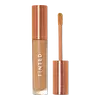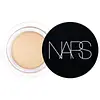What's inside
What's inside
 Key Ingredients
Key Ingredients

 Benefits
Benefits

 Concerns
Concerns

No concerns
 Ingredients Side-by-side
Ingredients Side-by-side

Water
Skin ConditioningShea Butter Ethyl Esters
EmollientPolyglyceryl-6 Pentaoleate
EmulsifyingIsoamyl Laurate
EmollientUndecane
EmollientGlycerin
HumectantDisteardimonium Hectorite
StabilisingCaprylic/Capric Triglyceride
MaskingTridecane
PerfumingJojoba Esters
EmollientMagnesium Sulfate
Niacinamide
SmoothingCaffeine
Skin ConditioningBakuchiol
AntimicrobialSodium Hyaluronate
HumectantSodium Hyaluronate Crosspolymer
HumectantHyaluronic Acid
HumectantHydrolyzed Hyaluronic Acid
HumectantAcacia Decurrens Flower Wax
EmollientAscorbyl Tetraisopalmitate
AntioxidantTocopherol
AntioxidantRaspberry Ketone
MaskingPersea Gratissima Oil
Skin ConditioningHelianthus Annuus Seed Wax
Skin ConditioningPhenoxyethanol
PreservativePropylene Carbonate
SolventGlycolipids
Skin ConditioningEthylhexylglycerin
Skin ConditioningPolyglycerin-3
HumectantPropanediol
SolventHydrolyzed Glycosaminoglycans
HumectantBenzyl Glycol
SolventCitric Acid
BufferingCI 77492
Cosmetic ColorantCI 77491
Cosmetic ColorantCI 77499
Cosmetic ColorantWater, Shea Butter Ethyl Esters, Polyglyceryl-6 Pentaoleate, Isoamyl Laurate, Undecane, Glycerin, Disteardimonium Hectorite, Caprylic/Capric Triglyceride, Tridecane, Jojoba Esters, Magnesium Sulfate, Niacinamide, Caffeine, Bakuchiol, Sodium Hyaluronate, Sodium Hyaluronate Crosspolymer, Hyaluronic Acid, Hydrolyzed Hyaluronic Acid, Acacia Decurrens Flower Wax, Ascorbyl Tetraisopalmitate, Tocopherol, Raspberry Ketone, Persea Gratissima Oil, Helianthus Annuus Seed Wax, Phenoxyethanol, Propylene Carbonate, Glycolipids, Ethylhexylglycerin, Polyglycerin-3, Propanediol, Hydrolyzed Glycosaminoglycans, Benzyl Glycol, Citric Acid, CI 77492, CI 77491, CI 77499
Dimethicone
EmollientWater
Skin ConditioningGlycerin
HumectantNylon-12
Butylene Glycol
HumectantParaffin
PerfumingDimethicone/Vinyl Dimethicone Crosspolymer
Skin ConditioningDicaprylyl Carbonate
EmollientPEG-10 Dimethicone
Skin ConditioningSorbitan Sesquiisostearate
EmulsifyingPEG-400
Emulsion StabilisingSilica
AbrasiveAluminum Hydroxide
EmollientPolysilicone-2
Microcrystalline Wax
Emulsion StabilisingCI 77120
Cosmetic ColorantDistearyldimonium Chloride
Palmitic Acid
EmollientHydrogen Dimethicone
Palmitoyl Tripeptide-5
Skin ConditioningTocopheryl Acetate
AntioxidantAscorbic Acid
AntioxidantRetinyl Palmitate
Skin ConditioningAlumina
AbrasiveSodium Acetylated Hyaluronate
HumectantTocopherol
AntioxidantPhenoxyethanol
PreservativeCI 77163
Cosmetic ColorantIron Oxides
Mica
Cosmetic ColorantCI 77891
Cosmetic ColorantDimethicone, Water, Glycerin, Nylon-12, Butylene Glycol, Paraffin, Dimethicone/Vinyl Dimethicone Crosspolymer, Dicaprylyl Carbonate, PEG-10 Dimethicone, Sorbitan Sesquiisostearate, PEG-400, Silica, Aluminum Hydroxide, Polysilicone-2, Microcrystalline Wax, CI 77120, Distearyldimonium Chloride, Palmitic Acid, Hydrogen Dimethicone, Palmitoyl Tripeptide-5, Tocopheryl Acetate, Ascorbic Acid, Retinyl Palmitate, Alumina, Sodium Acetylated Hyaluronate, Tocopherol, Phenoxyethanol, CI 77163, Iron Oxides, Mica, CI 77891
 Reviews
Reviews

Ingredients Explained
These ingredients are found in both products.
Ingredients higher up in an ingredient list are typically present in a larger amount.
Glycerin is already naturally found in your skin. It helps moisturize and protect your skin.
A study from 2016 found glycerin to be more effective as a humectant than AHAs and hyaluronic acid.
As a humectant, it helps the skin stay hydrated by pulling moisture to your skin. The low molecular weight of glycerin allows it to pull moisture into the deeper layers of your skin.
Hydrated skin improves your skin barrier; Your skin barrier helps protect against irritants and bacteria.
Glycerin has also been found to have antimicrobial and antiviral properties. Due to these properties, glycerin is often used in wound and burn treatments.
In cosmetics, glycerin is usually derived from plants such as soybean or palm. However, it can also be sourced from animals, such as tallow or animal fat.
This ingredient is organic, colorless, odorless, and non-toxic.
Glycerin is the name for this ingredient in American English. British English uses Glycerol/Glycerine.
Learn more about GlycerinPhenoxyethanol is a preservative that has germicide, antimicrobial, and aromatic properties. Studies show that phenoxyethanol can prevent microbial growth. By itself, it has a scent that is similar to that of a rose.
It's often used in formulations along with Caprylyl Glycol to preserve the shelf life of products.
Tocopherol (also known as Vitamin E) is a common antioxidant used to help protect the skin from free-radicals and strengthen the skin barrier. It's also fat soluble - this means our skin is great at absorbing it.
Vitamin E also helps keep your natural skin lipids healthy. Your lipid skin barrier naturally consists of lipids, ceramides, and fatty acids. Vitamin E offers extra protection for your skin’s lipid barrier, keeping your skin healthy and nourished.
Another benefit is a bit of UV protection. Vitamin E helps reduce the damage caused by UVB rays. (It should not replace your sunscreen). Combining it with Vitamin C can decrease sunburned cells and hyperpigmentation after UV exposure.
You might have noticed Vitamin E + C often paired together. This is because it is great at stabilizing Vitamin C. Using the two together helps increase the effectiveness of both ingredients.
There are often claims that Vitamin E can reduce/prevent scarring, but these claims haven't been confirmed by scientific research.
Learn more about TocopherolWater. It's the most common cosmetic ingredient of all. You'll usually see it at the top of ingredient lists, meaning that it makes up the largest part of the product.
So why is it so popular? Water most often acts as a solvent - this means that it helps dissolve other ingredients into the formulation.
You'll also recognize water as that liquid we all need to stay alive. If you see this, drink a glass of water. Stay hydrated!
Learn more about Water